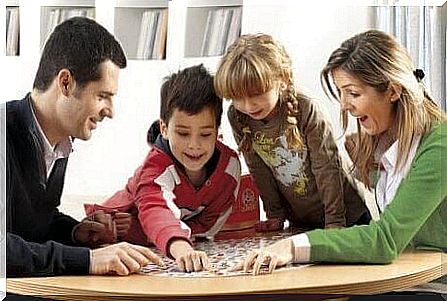6 Games That Stimulate The Brain

Discover a series of games that stimulate the brains of your children to play at home! All you need is some paper, crayons and a lot of imagination.
Learning through play: This is what parents should strive for when their children are on vacation. Of course, the summer holidays are intended to give children an opportunity to rest after a long school year. Still, it is still important to keep their brains active.
We do not mean that you should put your child with their textbooks to do monotonous mathematical and grammatical exercises, but rather that you should use games and games as a tool for your children to learn.
Homemade games that stimulate the brain
1. Memory
One of the most classic and simple games that is a big hit among younger children is memory. The dynamics of the game are just so captivating for children. But you can make it even more attractive and educational if you let your child participate in creating the game itself.
To make your own memory you need the following things:
- The pictures that your child wants to use
- Cardboard box

Have your children draw or cut out the pictures they want to use in the game (two copies per picture). Then glue the pictures on reasonably large pieces of cardboard. Make sure all pieces are the same size and color on the back.
To play, lay all the cards face down and then turn them over two at a time to form pairs. You will be amazed at how well your little ones can remember the positions of the different pictures!
This is a great game to train your visual acuity and memory. In addition, it is a fantastic activity that the whole family can have fun with together.
2. Alphabet Bingo
Alphabet Bingo is the perfect game to train the brain for children who have just learned their letters. It is a variant of the famous bingo game played with numbers.
You can create bingo game tiles yourself by using different colors for the letters. Your child will practice the alphabet without even realizing it while making the tiles.
When you play you can shout “bingo!” if you complete an entire line, or choose whether to fill the entire card first.
3. Puzzle
Another option for homemade games that stimulate the brain is to do puzzles. To make a quick and easy puzzle, you can cut puzzle pieces from an old brochure, magazine or something else you no longer use that has a picture or a nice pattern.
Puzzles are excellent for helping children practice logic and reasoning. They are also good for developing other abilities, such as their fine motor skills.
Another innovative variation of this classic activity is to create puzzles with Lego pieces. All you need is a pile of Lego pieces, a piece of cardboard where you can draw the pieces and a pencil or chalk.
Once you have drawn the outline of the Lego pieces and cut them out, mix them all together. Then your children can pair each piece of cardboard with its matching piece of Lego.
More homemade games that stimulate the brain
4. Find five errors

Drawing and coloring are favorite activities for children. Therefore, black and white images with “find five errors” are an excellent alternative, as children can color them afterwards.
The activity is just right for children who have difficulty staying concentrated and focused on a task for a long time. In addition, it helps them to develop their visual acuity.
You can search for completed “find five errors” pictures on the internet that you can print or you and your children can draw them themselves at home.
5. Treasure hunt
A treasure hunt is a good activity to develop your children’s ability to reason, as they must follow clues to find a hidden treasure. In addition, it develops their visual acuity, concentration and attention span.
There are many different ways to design a treasure hunt. For example, you can involve math problems, riddles or any other activity that allows your children to practice and develop their abilities.
6. Riddles
For the last activity, you do not need any materials at all – just your imagination. The words and rhymes you use to recite your riddles will fascinate your children and motivate them to come up with the answer.
As they do so, your children develop their imagination and thinking ability.









